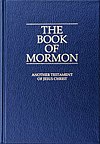|
Words of Mormon
The Words of Mormon is one of the books that make up the Book of Mormon, a text that is held sacred in the Latter Day Saint movement. It consists of a single chapter of eighteen verses and is the only book in the text which is not titled as a "book."[1] According to the text, it is a comment inserted by the prophet Mormon while compiling the records which became the Book of Mormon. Textually, Words of Mormon serves to link the Small Plates of Nephi, which precede it in the current printed version, but which would have been placed after Mormon's full record in the golden plates, with the rest of the Book of Mormon. NarrativeMormon explains that, while abridging the history of the Nephites, he came across the Small Plates of Nephi and decided to make them an appendix to his finished work.[2] He then briefly summarises the reign of King Benjamin, the last king named in the Small Plates. Mormon writes that King Benjamin, wielding the sword of Laban, stood against the Lamanites. With his efforts, and wisdom, and the help of the prophets, King Benjamin established peace in the land. Mormon also talks about how false Christs went among the people and were confounded.[3]
InterpretationSuggested purposesWords of Mormon verses 12–18 have continuity with the first part of Mosiah; Jack M. Lyon and Kent R. Minson hypothesize it was originally dictated as part of a now missing portion of the Book of Mosiah.[5] Brant Gardner suggests that Joseph Smith wrote verses 12–18 as a summary or bridge back into the large plates and that these verses were not part of the original dictation.[6] In another perspective, religious studies scholar Grant Hardy states that that Mormon's mention of King Benjamin links the Book of Omni with the Book of Mosiah.[7] Mormon narrates that he doesn't know why he is including the small plates with the large. Latter-day Saints believe that the inclusion serves as a replacement for the 116 pages that were lost during translation of the Book of Mormon.[8] Author Benjamin Keogh suggests that Mormon's explanation indicates that he views the inclusion of the small plates as an appendix to the larger record. Keogh further suggests that, for the small plates, Words of Mormon may serve a similar purpose as the title page of the Book of Mormon.[9] StyleDonald W. Parry broke up the Book of Mormon into its chiastic and other poetic patterns. In Words of Mormon he identified two instances of chiasmus: The first appears in verses 3-11 with an “ABcbcacababCDEFFEDCBabcA” pattern; the second is in verses 15-16 with an “abcabc” pattern.[10] In an article about the Words of Mormon, Benjamin Keogh searches for meaning in Mormon's frequent use of "these." Mormon, he suggests, may be referencing prophets, holy men, or the plates themselves.[11] Suggested prejudiceAuthors Fatimah Salleh and Margaret Hemming claim that throughout the narrative of the Book of Mormon the Nephites are prejudiced toward the Lamanites. They point out that in Words of Mormon the author calls the Lamanites the brethren of his people and avoids calling them his own brethren. This, Salleh and Hemming claim, is connected to Nephite prejudice.[12] References
Works cited
External links
|
